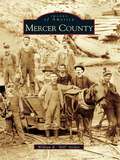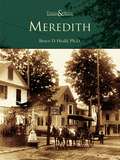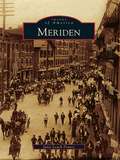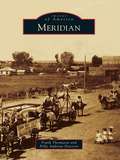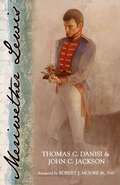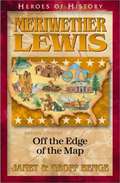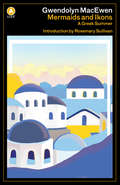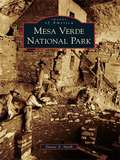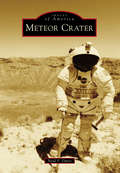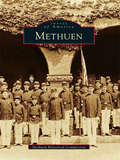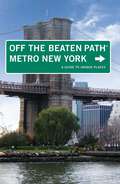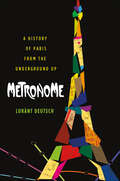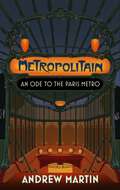- Table View
- List View
Mercer County
by William R. ArcherOriginating almost a quarter of a century prior to the Civil War, Mercer County, West Virginia was namedfor General Hugh Mercer, a Revolutionary War hero. The county has been a crossroads for many events, including the Civil War and the establishment of an industrial economy after the war ended. When two mighty railroads, the Norfolk & Western and The Virginian, began shipping coal and timber to the once-agrarian area, Mercer County blossomed into one of the five most highly populated counties of theMountain State. In 1671, colonial explorer Robert Fallam described what would become Mercer County in his journal as "a pleasing tho' dreadful sight to see the mountains and hills as if piled one upon another." Despite extreme challenges, residents ofMercer County developed a spirit of pride, independence, strength, and genuine fellowship that today makes the region a warm and friendly place to call home. As legend holds, even the notorious outlaw Frank James was so overwhelmed by the hospitality he received in Mercer County in 1882 thathe decided to pass on robbing the Bank of Princeton and, instead, robbed a bank in a neighboring county.
Merchantville (Images of America)
by Maureen A. MclooneOne hundred feet above the Delaware River is Merchantville, a spirited community founded in 1874. Many wealthy Philadelphia merchants established residences while others summered in this key South Jersey center for goods and services. In 1926, the building of the Benjamin Franklin Bridge opened the door to a new era of expansion, which continues today, as Merchantville forges ahead on its prosperous path. A sign of Merchantville's past and a crowning jewel of today is the wonderful Victorian architecture seen throughout town. Many historical homes still stand, lovingly restored and maintained by enthusiastic, caring residents. Merchantville includes a look at these great homes, as well as a chronicle of the town's greatest asset, its people. Boxing champion Jersey Joe Walcott, born in 1914 in Merchantville, trained right in the center of town; Jane Eayre Fryer wrote the Mary Frances series for young girls (1911-1918); and Wallis Warfield Simpson, later the Duchess of Windsor, visited Merchantville c. 1900. But everyday life and everyday residents are what make any study of history vital, and they are what make Merchantville so outstanding.
Mercury Pictures Presents
by Anthony MarraThe epic tale of a brilliant woman who must reinvent herself to survive, moving from Mussolini's Italy to 1940s Los Angeles-a timeless story of love, deceit, and sacrifice from the award-winning, New York Times bestselling author of A Constellation of Vital PhenomenaLike many before her, Maria Lagana has come to Hollywood to outrun her past. Born in Rome, where every Sunday her father took her to the cinema instead of church, Maria immigrates with her mother to Los Angeles after a childhood transgression leads to her father's arrest.Fifteen years later, on the eve of America's entry into World War II, Maria is an associate producer at Mercury Pictures, trying to keep her personal and professional lives from falling apart. Her mother won't speak to her. Her boss, a man of many toupees, has been summoned to Washington by congressional investigators. Her boyfriend, a virtuoso Chinese American actor, can't escape the studio's narrow typecasting. And the studio itself, Maria's only home in exile, teeters on the verge of bankruptcy.Over the coming months, as the bright lights go dark across Los Angeles, Mercury Pictures becomes a nexus of European émigrés: modernist poets trying their luck as B-movie screenwriters, once-celebrated architects becoming scale-model miniaturists, and refugee actors finding work playing the very villains they fled. While the world descends into war, Maria rises through a maze of conflicting politics, divided loyalties, and jockeying ambitions. But when the arrival of a stranger from her father's past threatens Maria's carefully constructed facade, she must finally confront her father's fate-and her own.Written with intelligence, wit, and an exhilarating sense of possibility, Mercury Pictures Presents spans many moods and tones, from the heartbreaking to the ecstatic. It is a love letter to life's bit players, a panorama of an era that casts a long shadow over our own, and a tour de force by a novelist whose work The Washington Post calls 'a flash in the heavens that makes you look up and believe in miracles.'
Mercury Pictures Presents
by Anthony MarraThe epic tale of a brilliant woman who must reinvent herself to survive, moving from Mussolini's Italy to 1940s Los Angeles-a timeless story of love, deceit, and sacrifice from the award-winning, New York Times bestselling author of A Constellation of Vital PhenomenaLike many before her, Maria Lagana has come to Hollywood to outrun her past. Born in Rome, where every Sunday her father took her to the cinema instead of church, Maria immigrates with her mother to Los Angeles after a childhood transgression leads to her father's arrest.Fifteen years later, on the eve of America's entry into World War II, Maria is an associate producer at Mercury Pictures, trying to keep her personal and professional lives from falling apart. Her mother won't speak to her. Her boss, a man of many toupees, has been summoned to Washington by congressional investigators. Her boyfriend, a virtuoso Chinese American actor, can't escape the studio's narrow typecasting. And the studio itself, Maria's only home in exile, teeters on the verge of bankruptcy.Over the coming months, as the bright lights go dark across Los Angeles, Mercury Pictures becomes a nexus of European émigrés: modernist poets trying their luck as B-movie screenwriters, once-celebrated architects becoming scale-model miniaturists, and refugee actors finding work playing the very villains they fled. While the world descends into war, Maria rises through a maze of conflicting politics, divided loyalties, and jockeying ambitions. But when the arrival of a stranger from her father's past threatens Maria's carefully constructed facade, she must finally confront her father's fate-and her own.Written with intelligence, wit, and an exhilarating sense of possibility, Mercury Pictures Presents spans many moods and tones, from the heartbreaking to the ecstatic. It is a love letter to life's bit players, a panorama of an era that casts a long shadow over our own, and a tour de force by a novelist whose work The Washington Post calls 'a flash in the heavens that makes you look up and believe in miracles.'(P) 2022 Penguin Audio
Meredith
by Bruce D. HealdThe history of Meredith as a corporate town dates back more than two hundred thirty years. Like most older towns, especially those devoted largely to agriculture, Meredith has greatly diminished in territory since its original incorporation; unlike most New Hampshire towns of this size, however, it is progressive and prosperous, and the valuation of the town has steadily increased. This growth is the result of Meredith's change from an agricultural town to an industrial town to today's prosperous four-season resort in the heart of the Lakes Region, at the foothills of the White Mountains. Meredith, part of the Then & Now series, places vintage images alongside contemporary photographs, taken by photographer Aaron Ober, to show the changes that have taken place in this area through the years.
Meriden
by Janis Leach FrancoIncorporated in 1806, Meriden was once proposed as the state capital. Although the plan was not implemented, the rural village quickly burgeoned into a major manufacturing center with the advent of the industrial revolution. Meriden advanced to become renowned as the "Silver City." International Silver Company and other key businesses, such as Parker Gun, Manning Bowman, Wilcox and White, and Handel Lamp, made Meriden a familiar name. Home to Gov. Abiram Chamberlain, Arctic explorer Hugh Johnson Lee, opera diva Rosa Ponselle, and baseball's Connie Mack, the city has also long been enlivened by a diverse mixture of immigrants and newcomers. Bordered on the north by dramatic traprock ridges, Meriden has a larger percentage of parklands than any other town in Connecticut, with Hubbard Park its crowning jewel.
Meridian
by Frank Thomason Polly Ambrose PetersonEight miles west of Idaho's capital city, Boise, the first settlers in what became Meridian found only arid land, sagebrush, and jackrabbits. The lone tree in the area was another 8 miles west in what became Nampa. Originally called Hunter, after a railroad superintendent, Meridian was initially a railway postal drop where workers tossed and hooked mailbags as the train passed through before the arrival of passenger service. By 1893, residents called the village Meridian, after the north-south prime meridian running through Meridian Road. In 1903, the village incorporated but still had a population of only a few hundred with grocery and harness shops and more churches than saloons. Village merchants and residents experienced orchard and dairy/creamery eras that ended in, respectively, the 1940s and 1970. Meridian became a city in the 1940s but 50 years later had a population of only 10,000. That number quadrupled over the next decade and today has nearly doubled again to around 80,000, as Meridian has evolved into the transportation and commercial hub of the Treasure Valley, especially in electronics and health care.
Meridian Hill: A History (Landmarks)
by Stephen R. McKevittIn the nineteenth century, Commodore David Porter built his mansion on a prominent hill sitting directly north of the White House, and the rest of Meridian Hill's history is indelibly tied to the fabric of Washington. John Quincy Adams once resided in Porter's mansion. Union troops used the estate and its lands during the Civil War. Later, part of the old estate was famously developed by Mary Henderson into a noted group of embassy mansions, and the extraordinary Meridian Hill Park was created. The rest of the land became a diverse, thriving residential neighborhood. Join local author Stephen McKevitt as he chronicles the fascinating story of this interesting urban locale in the nation's capital.
Meriwether Lewis
by Thomas C. Danisi John C. JacksonThe definitive biography on Meriwether Lewis by Thomas C. Danisi and John C. Jackson now in paperback for the first time.October 11, 2009 marks the bicentennial of Meriwether Lewis's death. As the leader of the Lewis and Clark expedition, an epic exploration of uncharted territory west of the Mississippi, Lewis has been the subject of several biographies, yet much of the published information is unreliable. A number of myths surrounding his life and death persist. Now independent scholars Thomas C. Danisi and John C. Jackson have written this definitive biography based on twelve years of meticulous research. They have re-examined the original Lewis and Clark documents and searched through obscure and overlooked sources to reveal a wealth of fascinating new information on the enigmatic character and life of Meriwether Lewis. Instead of focusing on the Lewis and Clark expedition, the authors concentrate on what Lewis was doing immediately before and after the journey through Western territory. They assess his role as a natural scientist and as governor of the Louisiana Territory. His lifelong mentor, Thomas Jefferson, thrust the latter role upon Lewis during a time of crisis. As Danisi and Jackson reveal, he would much rather have devoted this time compiling his notes and scientific findings into a vivid narrative of the expedition's adventures. Finally, using medical documentation, the book reveals the actual cause of Lewis's untimely death. The authors address both the conspiracy theories regarding murder as the cause of Lewis's death and the longstanding belief that he committed suicide. The Meriwether Lewis that emerges from this thoroughly researched biography is a man of honorable intentions who met severe challenges and handled difficult confrontations with patience and diplomacy. Both professional historians and armchair devotees of American history will want to add this important new work to their libraries.
Meriwether Lewis: Off the Edge of the Map (Heroes of History)
by Janet Hazel Benge Geoffrey Francis BengeA biography of the co-leader of the 1804-1806 Lewis and Clark expedition into the unmapped American West, including his early life and the formation of the Corps of Discovery.
Mermaids and Ikons: A Greek Summer
by Gwendolyn MacEwenAward-winning poet and novelist Gwendolyn MacEwen explores her strongly personal responses to the landscape, culture, and people of Greece in this exquisitely written travel diary, which was originally published in 1978.Originally published in 1978, beloved poet and novelist Gwendolyn MacEwen’s first work of nonfiction explores her strongly personal responses to a complex civilization. Partly written during a trip to Greece in 1971, MacEwen moves from the urban tumult of Athens to the radiant simplicity of an island in the Aegean. In this intimate and exquisitely written travel diary, she evokes the very spirit of Greece — the exuberance of the people, the sun-drenched landscape, and the shaping power of ancient traditions and myths in modern Mediterranean life.
Merritt Parkway, The: The Road that Shaped a Region (Transportation)
by Laurie Heiss Jill SmythDecorated with a breathtaking landscape and a treasured collection of diversely styled bridges, the Merritt Parkway runs thirty-seven and a half miles through Fairfield County. From its complicated beginnings to the present, authors Laurie Heiss and Jill Smyth navigate the hard-fought yet picturesque path of this beloved road. Meet the bridge artist, the landscapers, the politicians and the activists whose involvement in the Merritt transformed Fairfield County from farms and country estates to one of the wealthiest counties in the nation. With the dedication of preservationists and conservationists, the Merritt Parkway today remains both functional and beautiful, holding a unique place in the heart of Connecticut's drivers.
Mesa Verde National Park
by Duane A. SmithMesa Verde National Park was America's first cultural park and also the world's first cultural heritage park. Created in 1906, it preserves the sites and materials of the prehistoric Puebloan people. Located in southwestern Colorado near the famous Four Corners, where the states of Colorado, Utah, Arizona, and New Mexico meet, the magnificent Mesa Verde is situated in Montezuma County, just south of Cortez and directly west of Durango. The park's rich archaeological history was played out amid some of the most ruggedly beautiful landscapes in the West. The greater story of the evolution of the park encompasses the Ute people, Theodore Roosevelt, novelist Willa Cather, and other personalities. These remarkable vintage photographs tell that saga, which is as fascinating as that of the Puebloans.
Mesquite and the Virgin Valley
by Virgin Valley Historical Committee Geraldine White ZarateThe lower Virgin River basin is located about 10 miles south of the border junction between what is now Nevada, Arizona, and Utah. Early explorers told of blistering heat, disease-carrying insects, and scarce, evil-tasting water. But in 1877, the valley offered a haven to a small group of Mormon families who sought to live and practice their religious convictions, settling in Bunkerville on the south side of the Virgin River. On the north side, the struggle to establish Mesquite started in 1880. The third attempt in 1894 was successful after years of merciless floods. Residents have survived a hostile environment, geographic isolation, political gerrymandering, and in the middle of the last century, dangerous radiation fallout from atomic testing. Deep sand roads have given way to a bustling interstate highway, and the area has become a golf and gaming destination. After incorporation in 1984, Mesquite experienced a boom and has been named the fastest growing city of its size in the United States.
Messi: The must-read biography of the World Cup champion, now fully updated (Guillem Balague's Books)
by Guillem Balague'I have seen the player who will inherit my place in Argentine football and his name is Messi' Diego MaradonaFULLY UPDATED TO INCLUDE THE 2022 WORLD CUP TRIUMPH & MESSI'S TRANSFER TO INTER MIAMI As Lionel Messi raised the World Cup triumphantly into the air, the world watched on in awe. Messi's final peak conquered; his final dream achieved. It was the fairy tale ending to a glittering career. Yet despite delivering Argentina their third World Cup, Messi's time at Paris Saint-Germain came to a dramatic conclusion, and Miami awaited the Argentinian legend. Guillem Balagué has had unprecedented access to Messi's inner circle including the player himself: his coaches, team-mates and family. From tracing the origins of Messi's precocious talent in Rosario, Argentina, to chronicling his peerless seventeen-season career at Barcelona, and his tumultuous Parisian adventure, Guillem takes us behind-the-scenes of Messi's World Cup triumph and his long-desired move to the MLS. This is an epic, authoritative and compelling account of an enigmatic footballing genius. 'I can tell my grandkids one day that I coached Lionel Messi' Pep Guardiola
Messi: The must-read biography of the World Cup champion, now fully updated (Guillem Balague's Books)
by Guillem Balague'I have seen the player who will inherit my place in Argentine football and his name is Messi' Diego MaradonaFULLY UPDATED TO INCLUDE THE 2022 WORLD CUP TRIUMPH & MESSI'S TRANSFER TO INTER MIAMI As Lionel Messi raised the World Cup triumphantly into the air, the world watched on in awe. Messi's final peak conquered; his final dream achieved. It was the fairy tale ending to a glittering career. Yet despite delivering Argentina their third World Cup, Messi's time at Paris Saint-Germain came to a dramatic conclusion, and Miami awaited the Argentinian legend. Guillem Balagué has had unprecedented access to Messi's inner circle including the player himself: his coaches, team-mates and family. From tracing the origins of Messi's precocious talent in Rosario, Argentina, to chronicling his peerless seventeen-season career at Barcelona, and his tumultuous Parisian adventure, Guillem takes us behind-the-scenes of Messi's World Cup triumph and his long-desired move to the MLS. This is an epic, authoritative and compelling account of an enigmatic footballing genius. 'I can tell my grandkids one day that I coached Lionel Messi' Pep Guardiola
Metairie (Images of America)
by Catherine CampanellaMetairie was the first suburb of New Orleans; an outgrowth to the west by young families seeking larger lots, open air, and affordable new housing. Those suburbanites shared much in common with previous generations of New Orleanians who had migrated westward from the original town (now the French Quarter) to high land along the Mississippi River and the Metairie Ridge. When Jefferson Parish was established in 1825, it included all New Orleans faubourgs west of Felicity Street--what we now know as Uptown New Orleans. These would become the first cities in Jefferson Parish: Carrolton, Jefferson, and Lafayette. By the early 1900s, the westward expansion continued into what we now call Old Metairie and Bucktown. During the mid-20th century, Metairie boomed and is now one of the largest communities in Louisiana. While many residents consider themselves New Orleanians, even those born generations after their families moved to the suburb, Metairie has its own unique history.
Metaverse and Tourism: Rethinking Implications on Virtual Reality (Routledge Insights in Tourism Series)
by Marco Valeri Ahmad AlbattatThis innovative and timely book presents an in-depth analysis of how the metaverse revolutionizes tourism management, transforms consumer behaviour and motivates tourists to visit destinations.Adorned with illustrative tables, figures and diagrams throughout, the volume is data-led and explores how metaverse experiences affect tourist satisfaction and loyalty toward metaverse tourism. It also takes a future-focused approach and looks at and how the technologies of metaverse tourism will lead to a new level of immersive virtual reality. The book considers the metaverse in relation to the United Nations Sustainable Development Goals, post-COVID-19 society and offers practical insights on the topic.This book will be of pivotal interest for students, scholars and academics in the fields of tourism planning and policy, tourism economics, tourism behaviour and tourism development, as well as those with an interest in these areas more generally.
Meteor Crater (Images of America)
by Neal F. DavisThere have been numerous books and periodicals written about Meteor Crater, the meteorites, and the crater's scientific value, but this book, with supporting images, is more about people. The story covers some history of the crater's founding and the many people who have been, and presently are, associated with the custody and maintenance of the site, preserving it for future scientific study and generations of visitors. These people include geologists, astrophysicists, astronauts, generations of families named Barringer and Tremaine, and local ranchers named Chilson-Prosser. All have, and continue to, influence and shape what the site has become, each adding their signature to the famous landmark. Today, these families, supported by Meteor Crater Enterprises management and staff of dedicated people, continue the legacy of sharing the history and science with 250,000 annual visitors from around the globe while they continue to focus on preserving the scientific integrity of the crater for future generations.
Methuen
by Methuen Historical CommissionMethuen is located in the Merrimack Valley in northeastern Massachusetts. Thirty miles north of Boston, Methuen grew out of the Spicket Falls community during the 1800s as the Industrial Revolution arrived in this agricultural community.During this century, the town's wealthiest families, the Searles, the Tenneys, and the Nevins, brought both economic and cultural growth by building numerous mills, churches, schools, and museums in the area. The citizens, immigrants, and Yankees alikeformed the backbone and built the character of Methuen that can still be seen today. Methuen brings together many never-before-seen photographs dating from the earliest days of photography to the 1960s.The history of the town is the story of its people, from the farmers and mill workers to the millionaires and their descendants. Their stories are intertwined with the images of the changing landscape of Methuen, including landmarks, storefronts, schools, and houses of worship. Some can still be seen today, while others exist only in memories.
Metro Detroit's High School Basketball Rivalries (Images of Sports)
by T. C. CameronFew cities can claim a hardwood heritage like that found in metro Detroit. Metro Detroit has been the epicenter for cataclysmic change in the past 60 years that no other major American city has suffered, but the one constant among so much upheaval is a passionate following afforded high school basketball. The rise and fall of the automotive industry, the Motown record label's emergence and eventual relocation, social and racial unrest, and the polarization of one of America's great cities has not slowed the love and passion Detroiters-city and suburban dwellers alike-share for prep basketball.
Metro New York Off the Beaten Path®: A Guide to Unique Places (Off the Beaten Path Series)
by Susan FinchTired of the same old tourist traps? Whether you&’re a visitor or a local looking for something different, let this first edition of Metro New York Off the Beaten Path show you the metro New York City region you never knew existed. Visit a sizable chunk of the Berlin Wall—in Battery Park. Attend a session of Night Court. Discover isolated and tranquil spots scattered across the five boroughs and beyond—including nearly forgotten islands, tucked away beaches, wildlife sanctuaries, a working farm, subway tunnel tours, crumbling ruins, and bizarre haunts in the middle of one of the planet&’s most visited cities. So if you&’ve &“been there, done that&” one too many times, get off the main road and venture Off the Beaten Path.
Metro Stop Dostoevsky: Travels in Russian Time
by Ingrid BengisA Russian American writer catapults herself into the maelstrom of Russian life at a time of seismic change for bothThe daughter of Russian émigrés, Ingrid Bengis grew up wondering whether she was American or, deep down, "really Russian." In 1991, naïvely in love with Russia and Russian literature, she settled in St. Petersburg, where she was quickly immersed in "catastroika," a period of immense turmoil that mirrored her own increasingly complex and contradictory experience. Bengis's account of her involvement with Russia is heightened by her involvement with B, a Russian whose collapsing marriage, paralleling the collapse of the Soviet Union, produces a situation in which "anything could happen." Their relationship reflects the social tumult, as well as the sometimes dangerous consequences of American "good intentions." As Bengis takes part in Russian life-becoming a reluctant entrepreneur, undergoing surgery in a St. Petersburg hospital, descending into a coal mine-she becomes increasingly aware of its Dostoevskian duality, never more so than when she meets the impoverished, importuning great-great-granddaughter of the writer himself. Beneath the seismic shifting remains a centuries-old preoccuption with "the big questions": tradition and progress, destiny and activism, skepticism and faith. With its elaborate pattern of digression and its eye for the revealing detail, Bengis's account has the hypnotic intimacy of a late-night conversation in a Russian kitchen, where such questions are perpetually being asked.
Metronome: A History of Paris from the Underground Up
by Loránt DeutschA phenomenal bestseller in France, Metronome presents a fascinating history of Paris through the lens of the city's iconic Metro systemDid you know that the last Gallic warriors massacred by the Romans lie beneath the Eiffel Tower? That the remains of Paris's first cathedral are under a parking lot in the Fifth District? Metronome follows Loránt Deutsch, historian and lifelong Francophile, as he goes on a compelling journey through the ages, treating readers to Paris as they've never seen it before. Using twenty-one stops of the subway system as focal points—one per century—Deutsch shows, from the underground up, the unique, often violent, and always striking events that shaped one of the world's most romanticized city. Readers will find out which streets are hiding incredible historical treasures in plain sight; peer into forgotten nooks and crannies of the City of Lights and learn what used to be there; and discover that, however deeply buried, something always remains.
Metropolitain: An Ode to the Paris Metro
by Andrew MartinAndrew Martin has been described as 'the laureate of railways', having written many books with railway themes. But Andrew has always been obsessed with the Paris Metro, hence Metropolitain: An Ode to the Paris Metro, the first English history of the Metro for the general reader.Metropolitain is as stylish as the Metro itself and laced with cultural references. Andrew explains why Last Tango in Paris is a great Metro film, and what the Metro chase scene in the classic thriller, Le Samourai, says about Parisian culture. He describes how he came to appreciate the beauty of Guimard's sinuous green Metro entrances when he bought a lily of the valley and observed it flowering on his desk. We meet Andrew's half-English, half-French friend, Julian, who runs a society dedicated to Metro history. He tells Andrew, 'A Metro station is like the wine cellar of chateau, which is a very nice thing to be reminded of.'The book takes the reader on a constant tour of Paris, both underground and over. But Paris, and the Metro, is changing, undergoing a huge expansion. This, and the imminence of the Paris Olympics, make this a timely title.
